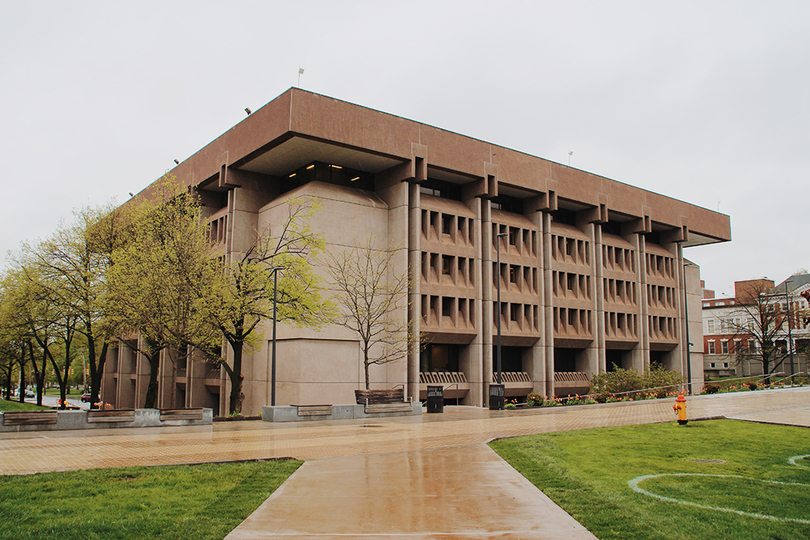SU Libraries opens a new storage vault for historical materials on South Campus

SU Libraries opened a new 14,000 square foot storage vault this summer to store delicate historical materials, such as film negatives, artwork, and books from its Special Collections Research Center. Micaela Warren | Photo Editor
Get the latest Syracuse news delivered right to your inbox.
Subscribe to our newsletter here.
Sealed boxes sit on pallets on Syracuse University’s South Campus waiting to be processed before they enter the cold, dry vaults of SU Libraries’s storage facility. Those who work in the facility or visit it from Bird Library, such as Melinda Dermondy, make sure to put on an extra layer before they enter the rows of 12-foot-high shelves.
“Library collections grow, but the building doesn’t grow,” said Dermody, the interim associate dean for academic success for SU Libraries. “So at some point, we just have exceeded the space to store the collection, and so we built this high density storage facility.”
SU Libraries opened a new 14,000 square foot storage vault this summer to store delicate historical materials, such as film negatives, artwork, and books from its Special Collections Research Center. The new storage “module” is an addition to the existing structure on South Campus that houses the original module. Materials come to the modules to be stored from the SCRC, which is located on the sixth floor of Bird Library.
When the first module was opened ten years ago, SU Libraries’ plan was to eventually have a total of three storage facilities, Dermody said. The module now stores materials from the General Collections and the SCRC while the second is exclusively devoted to SCRC materials.
“It was a way to safely store and extend the life of material, but also create much needed storage space so that the libraries could get more material and also be used for other things,” she said.
The new vault in the second module is kept at 35% humidity and 25 degrees Fahrenheit at all times. The cool and dry environment is designed to preserve the materials within it. The rest of module two and module one is kept at 50 degrees Fahrenheit and 30% humidity.
The freezer environment is optimal for “time-sensitive materials,” such as film negatives and tapes, that can have their lifetime extended by 200 to 250 years by being stored in this way, Dermody said.
In March 2021, SU approved plans for the addition of a secure, climate-controlled facility onto Module 1 in 2016. But the project was delayed until this past spring.
It is unclear why exactly the project was halted, but the University Senate Committee on the Libraries raised concerns in February that the university instead prioritized renovations on the Dome and Schine Student Center and construction on the National Veterans Resource Center.
Artifacts in the library’s possession were deteriorating without climate control. The new vault was eventually pushed through by Joan Breier Brodsky, a member of the Library Advisory Board, after she donated $150,000 dollars to complete the project.

Over this past summer, the library began moving theses and dissertations from SU students into the new storage unit.
“Student work — student thought — came first and will be kept in perpetuity down here,” said Nicolette Dobrowolski, assistant director of access services at SU Libraries.
Dobrowolski said that the location of the storage facility on South Campus is convenient for processing materials and retrieving items. When a request for an item is submitted, SU Libraries will deliver the item within 24 hours or by the next workday, Dobrowolski said.
David Stokoe, a conservation librarian at SU, said the university considered off-campus commercial locations for the new facility, but the distances and cost to transport the materials were too great.
Once the funding for the new construction was approved, the library staff faced the challenges of building the necessary customizations and beginning the transfer process for the collection.
“We work to identify the things that are the most urgent to move in, so the things that are most vulnerable, the things where, as time passes and each day passes, items that are degrading,” Dermody said.
SU Libraries lends materials from the SCRC to students, faculty, and other universities through the InterLibrary Loan system. Dobrowolski said that SU is second in the nation for the largest amount of materials lent to other institutions.
Tony Carbone, the facility manager, said that the storage facility usually gets around 300 individual requests for materials every month.
The SCRC preps the materials for storage in Bird Library, processed for inventory, given barcodes, and then put onto pallets for Carbone and his team to pick up and take to the facility.
The facility stores items by size, rather than subject matter or call number, to maximize cubic square footage of the space, Carbone said. The facility uses a triple-barcode system to identify what an item is and where it belongs.
Dermody said that SU Libraries hasn’t lost any materials during the transition of materials between Bird Library and the storage facilities.
“That is the goal, to never lose anything,” Dermody said. “And we have not, and the (barcode system) is a pretty simple but effective and critical process.”
Now that SU Libraries has completed the second module and materials are starting to populate its shelves, Dermody said that the next step is to look at plans for building a third module which would contain more of the library’s general collection.
“Even though there’s more and more electronic (material), we still have a lot of physical collections, we still have a lot of other uses for the library as well, so we continue to have the need for additional storage,” Dermody said.





